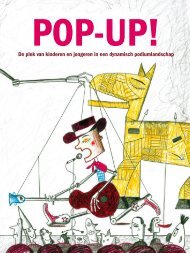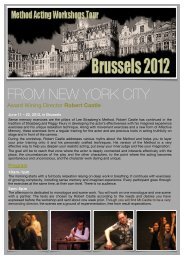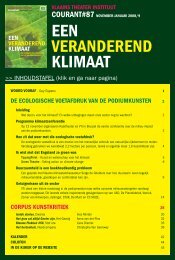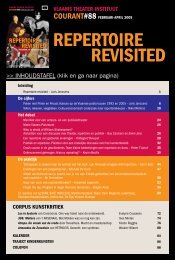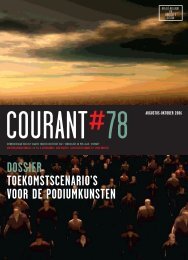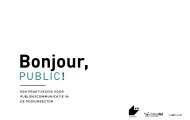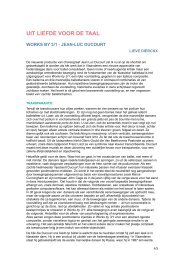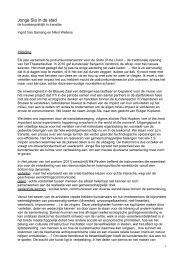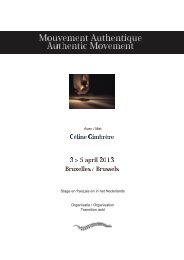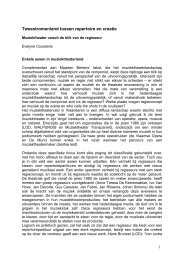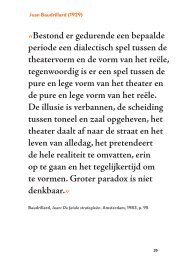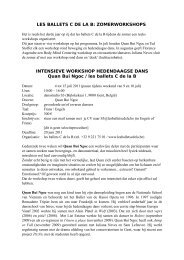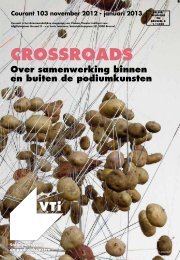Create successful ePaper yourself
Turn your PDF publications into a flip-book with our unique Google optimized e-Paper software.
josse de pauw<br />
The wanderer in the landscape:<br />
artistic context and reception<br />
Josse <strong>De</strong> <strong>Pauw</strong> has never worked very much in the larger Flemish<br />
companies. He always continued to hone his own approach,<br />
which he was free to mark out in the so-called ‘secondary circuit’.<br />
Nevertheless, in the Radeis performances he at one time<br />
encountered, and supplied inspiration to, the innovative movements<br />
of the eighties and the present generation of play-makers<br />
have probably learnt something from him too – even though his<br />
career has not always been seen as a continuous thread. The fact<br />
that Josse <strong>De</strong> <strong>Pauw</strong> is usually understood to be a loner and not<br />
as part of the shifting panoramic landscape of theatre is sustained<br />
by several factors. There is for instance his loyalty to an artistic<br />
family, the need to be able to work in peace and the somewhat<br />
slow tempo at which new productions appear. In addition, the<br />
need to play various fields, both in theatre and the other arts,<br />
means that he is hard to force into one particular tradition or<br />
development in theatre. Yet <strong>De</strong> <strong>Pauw</strong> is in this regard by no<br />
means alone in Dutch-language theatre. In fact, by consciously<br />
standing on the sidelines of the theatre establishment, he more<br />
than once ended up at the heart of theatrical renewal.<br />
The first extremely important event in this respect was the development<br />
of Radeis. Not only did the group’s international reputation<br />
have a great influence on the development of Kaaitheater<br />
(festival and organisation), but in addition, in the early eighties<br />
Radeis’ wordless theatre contributed to the emergence of the radically<br />
renewed discourse on physical theatre and contemporary<br />
dance in Flanders. Their unconventional handling of visuality<br />
and the body, free from traditional theatres of movement and<br />
objects, was a step in this direction. Furthermore, their frivolous,<br />
disarticulating and often mildly destructive treatment of theatre<br />
conventions undoubtedly had an influence on postmodern theatre<br />
productions in subsequent years.<br />
Against the background of what was later to be labelled the theatrical<br />
renewal of the eighties, Radeis was very early in making an<br />
impression: they were already working on their own house style<br />
in 1977, one which was also enthusiastically received abroad<br />
after 1980. The whole Radeis repertoire had already been (pro-<br />
50 / Kritisch Theater Lexicon - 14 e - August 2001<br />
structural and artistic context<br />
visionally) shaped before 1981, whereas controversial productions<br />
by Jan <strong>De</strong>corte (Maria Magdalena), Ivo Van Hove (<strong>De</strong><br />
Geruchten), Herman Gilis (Het Laxeermiddel) and Jan Fabre<br />
(Het is theater zoals te verwachten en te <strong>voor</strong>zien was) only<br />
appeared as from that year. Even the other two resident Schaamte<br />
companies, Anne Teresa <strong>De</strong> Keersmaeker with Rosas and Jan<br />
Lauwers’ Epigonentheater, only really started to operate fully in<br />
the early eighties.<br />
The influence (direct and indirect) of Radeis cannot be separated<br />
from the interaction with the international theatre scene. For<br />
Belgium, Radeis were a successful company abroad, which at the<br />
same time opened up the borders in order both to bring in other<br />
innovative companies (The Wooster Group, Pina Bausch, Jürgen<br />
Gosch, Maatschappij Discordia, etc.) and to promote its own<br />
groups abroad. The boundary-breaking nature of this new generation,<br />
in terms of both geography and form and discipline, had<br />
found a wordless messenger in Radeis. This group’s acutely<br />
funny and, most importantly, unpretentious theatre was sufficient<br />
to burst forever the petrified legacy of the late seventies.<br />
Not by using the tough approach of what was later to be labelled<br />
the ‘Flemish wave’, but with jollity, subtlety and, above all,<br />
aware of the relative nature of every theatre tradition. Whereas<br />
others, mainly because they were unhappy with dramatic arts<br />
education in their own country, looked for new languages of<br />
movement elsewhere, Radeis sought renewal within itself and in<br />
the tradition of popular theatre, by upsetting the old theatrical<br />
codes. Radeis was at the same time a very early exponent (e.g. in<br />
their opposition to the increasingly slogan-based theatre of political<br />
awareness) and stimulator of theatrical renewal, which was<br />
accompanied by a changed attitude to the actor and the dramaturgical,<br />
disciplinary and stage material used. Old dramatic<br />
precepts were unremittingly attacked. It was, for example, no<br />
longer necessary to play characters. Empathic-portrait acting and<br />
pedantic acting were replaced by acting oriented very much to<br />
the ‘here and now’, which consciously dealt with such notions as<br />
the distance and proximity of the character and the person. The<br />
use of the dialogue-based dramatic text gave way to an abundant<br />
variety of materials and disciplines with which one entered into<br />
a ‘dialogue’.<br />
51 / Kritisch Theater Lexicon - 14 e - August 2001



